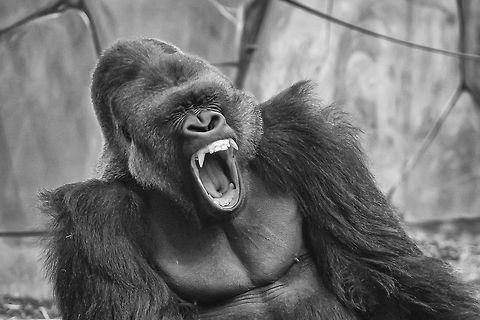
Appearance
The western lowland gorilla is the smallest subspecies of gorilla but nevertheless still a primate of exceptional size and strength. This species of gorillas exhibits pronounced sexual dimorphism. They possess no tails and have jet black skin along with coarse black hair that covers their entire body except for the face, ears, hands, and feet. The hair on the back and rump of males takes on a grey coloration and is also lost as they get progressively older. This coloration is the reason why older males are known as "silverbacks". Their hands are proportionately large with nails on all digits, similar to that of a human's, and very large thumbs. They have short muzzles, a prominent brow ridge, large nostrils, and small eyes and ears. Other features are large muscles in the jaw region along with broad and strong teeth.A male standing erect can be 5–6 feet tall and weigh 300–600 pounds . According to the Guinness Book of World Records, the average male is 168 kg and stands upright at 163 cm . Western gorillas frequently stand upright, but walk in a hunched, quadrupedal fashion, with hands curled and knuckles touching the ground. This style of movement requires long arms, which works for western gorillas because the armspan of gorillas is larger than their standing height. Males in captivity, however, are noted to be capable of reaching weights up to 275 kg. Females stand 5 feet tall and weigh half as much as males. According to the late John Aspinall, a silverback gorilla in his prime has the physical strength of 7–8 Olympic weight lifters but this claim is unverified.
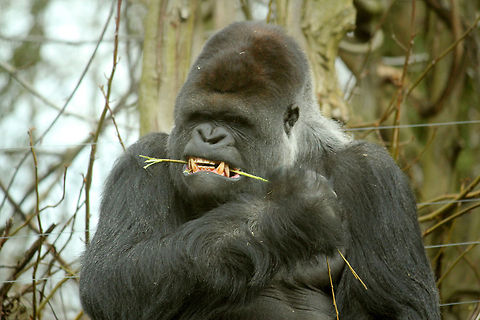
Distribution
The western lowland gorilla population in the wild is faced by a number of factors that threaten its extinction. Such factors include deforestation, farming, grazing, and the expanding human settlements that cause forest loss. There is a correlation between human intervention in the wild with the destruction of habitats and increase in bushmeat hunting.Another of these factors is infertility. Generally, female gorillas mature at 10–12 years of age and their male counterparts mature slower, rarely strong and dominant enough to reproduce before 15–20 years of age. The fecundity of females, or capacity of producing young in great numbers, appears to decline by the age of 18. Of one half of captive females of viable reproductive age, approximately only 30% of those had only a single birth. The long, narrow, bony pelvis of the great apes, which further contributes to the potentially long distance from the apex of the vagina to the ovaries and therefore decreases the chance of successful fertilization. However, these non-reproductive gorillas may prove to be a valuable resource since the use of assisted reproductive techniques aid in the maintaining of genetic diversity in the limited population in zoos.
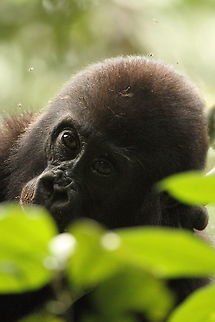
Status
In the 1980s, a census of the gorilla populations in equatorial Africa was thought to be 100,000. Researchers later adjusted the figure to less than half because of poaching and diseases. Surveys conducted by the Wildlife Conservation Society in 2006 and 2007 found about 125,000 previously unreported gorillas have been living in the swamp forests of Lake Télé Community Reserve and in neighboring Marantaceae forests in the Republic of the Congo. However, gorillas remain vulnerable to Ebola, deforestation, and poaching.In 2002 and 2003, there was an Ebola outbreak in the Lossi sanctuary population, and in 2004, there was an Ebola outbreak in the Lokoué forest clearing in Odzala-Kokoua National Park, both in the Republic of the Congo. The Ebola outbreak in the Lokoué forest clearing negatively affected the individuals living in groups and the adult females more than the solitary males, resulting in an increase in the proportion of solitary males to those living in groups. This population decreased from 377 individuals to 38 individuals two years after the outbreak, and to 40 individuals six years after the outbreak. The population is still slowly recovering, even today, hopefully towards a population that has the same demographic structure of an unaffected population, because of new births and breeding groups. This Ebola outbreak also affected the Maya Nord population from 400 individuals to considerably less. Because of these outbreaks, the International Union for Conservation of Nature updated the status of western lowland gorillas from "endangered" to "critically endangered".
In the northeastern part of the Republic of the Congo, even though poaching is illegal, western lowland gorillas are still being hunted for their bushmeat and the young for pets; five percent of the species is killed each year because of this. Deforestation of this area allows for the trade of bushmeat and even more poaching."Western Lowland Gorilla." World Wildlife Fund. Ed. Matthew Lewis and Richard Carroll. N.p., 2013. Web. 24 Oct. 2013. . Commercial poaching of chimpanzees, forest elephants, and western gorillas in The Republic of the Congo resulted from the increased amount of commercial logging and infrastructure. Deforestation and logging allowed for the creation of roads which allowed hunters to hunt deeper into the forests, increasing the amount of poaching and bushmeat trade in the area. The Republic of the Congo has put in place a conservation effort to conserve different species such as chimpanzees, forest elephants, and western gorillas from poaching and deforestation. This conservation effort would allow these species to benefit from vegetation and ecologically important resources.
Bush meat hunting along with timber harvesting in the Western Lowland gorilla’s habitat has significantly impacted the probability of its survival. The Western Lowland gorilla is considered to be critically endangered by the IUCN. The Western Lowland gorillas, like many gorillas, are essential to the composition of the rainforest due to its seed distribution. The conservation of the Western Lowland gorilla has been made a priority by many organizations. The Wildlife Conservation society has been working with the local community in the Congo Basin to establish wildlife management programs. The WCS is also working in Congo and surrounding countries to limit the bush meat trade by enforcing laws and hunting restrictions and also helping the local people find new sources of protein."Western Lowland Gorilla." – Saving Wildlife. N.p., n.d. Web. 24 Oct. 2013. .
Zoos worldwide have a population of 550 western lowland gorillas and the Cincinnati Zoo leads the United States in western lowland gorilla births.
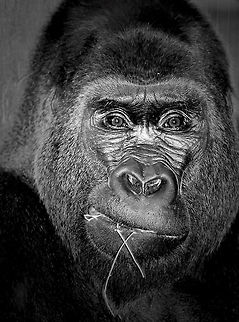
Behavior
Western lowland gorilla groups travel within a home range averaging 3–18 sq mi . Gorillas do not display territorial behavior, and neighboring groups often overlap ranges. The group usually favours a certain area within the home range but seems to follow a seasonal pattern depending upon the availability of ripening fruits and, at some sites, localised large open clearings . Gorillas normally travel 0.3–1.8 mi per day. Populations feeding on high-energy foods that vary spatially and seasonally tend to have greater day ranges than those feeding on lower-quality but more consistently available foods. Larger groups travel greater distances in order to obtain sufficient food....hieroglyph snipped... Human hunters and leopards can also influence the movement patterns.It was found that it is easier for males to travel alone and move between groups as a result of the solidarity they experienced before finding their own breeding group. Before reaching the age of sexual maturity, males leave their natal group and go through a “bachelor stage” that can last several years either in solidary or in a nonbreeding group. However, while both sexes leave their birth group, females are never found alone; they just travel from breeding group to breeding group. It was also found that males like to settle with other male members of their family. Their breeding groups consist of one silverback male, three adult females and their offspring. The male gorilla takes on the role as the protector. Females tend to make bonds with other females in their natal group only, but rather form strong bonds with males. Males also compete aggressively with each other for contact to females.
The group of gorillas is led by one or more adult males. In cases where there are more than one silverback males in a group, they are most likely father and son. Groups containing only one male are believed to be the basic unit of the social group, gradually growing in size due to reproduction and new members migrating in. In the study done at Lope, gorillas harvest most of their food arboreally, but less than half of their night nests are built in trees.
They are often found on the ground, and are made up of up to 30 gorillas. Western lowland gorillas live in the smallest family groups of all gorillas, with an average of 4 to 8 members in each. The leader organizes group activities, like eating, nesting, and traveling in their home range. Those who challenge this alpha male are apt to be cowed by impressive shows of physical power. He may stand upright, throw things, make aggressive charges, and pound his huge chest while barking out powerful hoots or unleashing a frightening roar. Despite these displays and the animals' obvious physical power, gorillas are generally calm and nonaggressive unless they are disturbed. Young gorillas, from three to six years old, remind human observers of children. Much of their day is spent in play, climbing trees, chasing one another, and swinging from branches.
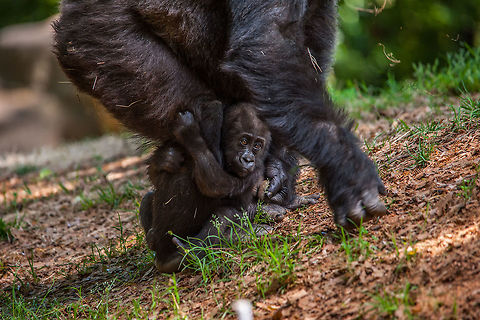
Habitat
Western Lowland Gorillas primarily live in rain forests, swamp forest, brush, secondary vegetation, clearing and forest edges, abandoned farming fields, and riverine forests. They live in primary and secondary lowland tropical forests that have elevations that extend from sea level up to 1,300 meters. The average amount of rainfall in the areas where Western Lowland Gorillas typically reside is about 1,500 millimeters a year with the greatest rainfall between the months of August and November. Western Lowland Gorillas are not typically observed in areas close that are close to human settlements and villages. They have been known to avoid areas with roads and farms that show signs of human activity. These gorillas favor areas where edible plants are more copious. Swamp forests are now considered important feeding areas and habitats for the western lowland gorilla. These areas support the gorillas in both the wet and the dry season of the forest. The forests of the Republic of Congo are currently considered to host the majority of the western lowland gorilla population. The forests of the Republic of Congo serve as protection to the gorillas with the isolation of the large swampy forest areas.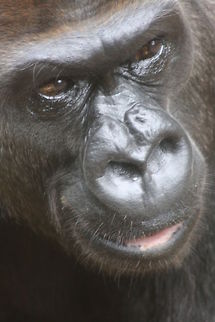
Reproduction
Female Western lowland gorillas do not produce many offspring due to the fact that they do not reach sexual maturity till the age of 8 or 9. Female gorillas give birth to one infant after a pregnancy of nearly nine months. Unlike their powerful parents, newborns are tiny—weighing four pounds—and able only to cling to their mothers' fur. These infants ride on their mothers' backs from the age of four months through the first two or three years of their lives. Infants can be dependent on their mother for up to five years.A study of over 300 births to captive female gorillas revealed that older females tend to give birth to more male offspring as opposed to females under 8 years old. This pattern is likely to result from selective pressures on females to have males at a time when they can provision them most effectively, as male reproductive success probably varies more than that of females and depends more on the maternal role.Mace, G.M. "Birth Sex Ratio and Infant Mortality Rates in Captive Western Lowland Gorillas." Folia Primatologica. 55.3-4 : 156-165. Web. 24 Oct. 2013.
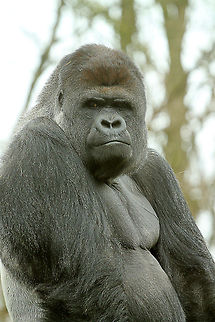
Food
In tropical forests a lot of hunting is taking place to provide meat for the bushmeat trade. This is affecting the western lowland gorillas by making them critically endangered because they are being hunted. Furthermore, during the process of hunting not only are the western lowland gorillas victims of being hunted, it is destroying the habitats of the few western lowland gorillas that are left.Likewise, logging is also destroying their habitats. One positive effect on the gorillas from logging though is that it provides herbaceous vegetation for the gorillas to eat and the gaps the logging causes allows for feeding and nesting for the gorillas. Although, there are some positive aspects for the gorillas from logging in the forests, the main issue is that logging is destroying the habitats of the gorillas. The gorillas' habitats being destroyed are harmful to the gorillas because it is causing them to have no place to live, but it is also harmful to the rest of the forest. Western lowland gorillas are seed dispersers, which mean they carry seeds from one place to another, and this trait is beneficial to many of the animals in the forest. Therefore, if there are no western lowland gorillas to disperse the needed seeds to other animals, not only will the gorillas become extinct but so will many other animals, which could overtime destroy an entire ecosystem.As herbivores, the main diet of western lowland gorilla groups is roots, shoots, fruit, wild celery, tree bark and pulp which is provided for in the thick forests of central and west Africa. They may also eat insects from time to time. The adult will eat around 18 kg of food per day. Gorillas will climb trees up to 15 meters in height in search of food. They never completely strip vegetation from a single area since the rapid regrowth of the vegetation allows them to stay within a reasonably confined home range for extended periods of time.
The Western Lowland Gorilla eats a combination of fruits and foliage, providing a balance of nutrients, depending on the time of year. However, when ripe fruit is available, they tend to eat more fruit as opposed to foliage. When ripe fruit is in scarce supply, they eat leaves, herbs, and bark. During the rainy months of July and August fruit is ripe; however in the dry seasons, ripe fruit is scarce. Gorillas choose fruit that is high in sugar for energy, as well as fiber.
References:
Some text fragments are auto parsed from Wikipedia.